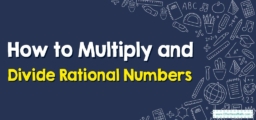How to Use a Venn Diagram to Classify Rational Numbers?

A Step-by-step Guide to Using a Venn Diagram to Classify Rational Numbers
Using a Diagram to Classify Rational Numbers – Examples 1
Using a Diagram to Classify Rational Numbers – Examples 2
Solution:
Step 1: Draw a large rectangle to represent the set of all real numbers.
Step 2: Draw two overlapping circles inside the rectangle, one to represent the set of rational numbers and the other to represent the set of irrational numbers.
Step 3: Label the circle representing rational numbers as \(“Q”\) and the circle representing irrational numbers as \(“I”\).
Step 4: Shade the region inside the circle \(“Q”\) to show all the rational numbers. This includes all fractions, integers, terminating decimals, and repeating decimals.
Step 5: Shade the region inside the circle \(“I”\) to show all the irrational numbers. These include numbers that cannot be expressed as a ratio of two integers, such as the square root of \(2\) or pi.
Now we can classify the given numbers:
\(-4\): Rational (an integer)
\(\frac{7}{9}: Rational (a fraction)
\(\sqrt{9}\): Rational (an integer)
\(0.75\): Rational (a terminating decimal)
\(\sqrt{5}\): Irrational (a number that cannot be expressed as a ratio of two integers)
\(2.4\): Rational (a terminating decimal)
Related to This Article
More math articles
- 5th Grade OSTP Math Worksheets: FREE & Printable
- Best Calculator for College Algebra
- How to Choose the Best Backup Software Solution for School Districts?
- The Ultimate Precalculus Course (+FREE Worksheets & Tests)
- 5th Grade AZMerit Math Worksheets: FREE & Printable
- How to Understand Decimals Conveyed in Words
- Ratio, Proportion and Percentages Puzzle – Challenge 28
- Discovering the Magic of ASA and AAS Congruence in Triangles
- The Ultimate ATI TEAS 7 Math Course (FREE Worksheets)
- 5th Grade SBAC Math Worksheets: FREE & Printable




























What people say about "How to Use a Venn Diagram to Classify Rational Numbers? - Effortless Math: We Help Students Learn to LOVE Mathematics"?
No one replied yet.